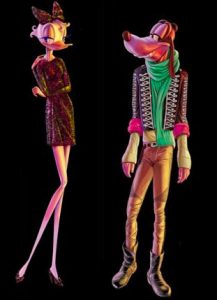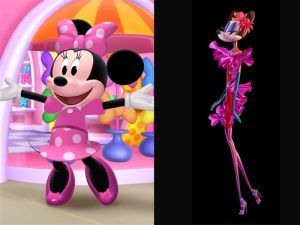When the high-end department store Barney’s decided to collaborate with Disney for its holiday window, Barney’s creative director, David Freedman insisted that, “the important thing to me was always that it had to be authentic. It really had to hit the nail on the head in every detail.” When it came to the Disney characters, however, he decided to do the exact opposite: “When we got to the moment when all Disney characters walk on the runway, there was a discussion. The standard Minnie Mouse will not look so good in a Lanvin dress.”
So they gave Minnie, along with Daisy Duck, a makeover. Both characters were drastically morphed from the bodies we know and love into 5’11, size 0 models. To be clear, there is absolutely nothing wrong with a 5’11, size 0 body; however, there is something very wrong with changing the body of a beloved children’s character so that it looks good in a dress that almost nobody looks good in.
Although Barneys and Disney believe that these drastic makeovers are just a bit of fashion fun, the truth is that they are sending young girls a dangerous message. Most of Minnie’s fans will not grow up to be 5’11 size 0 models. Why not teach those girls, the vast majority of girls, that it’s time to demand a designer who is talented enough to make dresses that work for more than one body type? Instead, two huge corporations who are in a position to have a tremendous amount of influence on young girls have chosen to send the message that if they don’t “look good” in a Lanvin dress they should drastically change their bodies.
As a society we need to realize that the problem isn’t with Minnie’s body, it’s with fashion moguls like Barney’s, which insist on catering their designs for a small minority of women. The association between promoting a thin ideal and eating disorders in children cannot be ignored. According to a report issued by the American Academy of Pediatrics (AAP) published in the journal Pediatrics, hospitalizations for eating disorders in children younger than 12 years old rose 119% from 1999 to 2006. Further statistics cited on the non-profit National Association of Anorexia and Associated Eating Disorders website further reaffirm that media messaging does have an impact:
•47% of girls in 5th-12th grades reported wanting to lose weight because of magazine pictures.
• 69% of girls in 5th-12th grades reported that magazine pictures influenced their idea of a perfect body shape.
• 42% of 1st-3rd grade girls want to be thinner.
• 81% of 10 year olds are afraid of being fat.
This is what happens when a culture puts girls under tremendous pressure to meet a single, stereotypical, Photoshop-perfect beauty ideal. It’s what happens when the First Lady of the United States wages war on fat children. People are saying enough is enough. A petition I launched on Change.org asking Barneys and Disney to leave Minnie Mouse alone has over 137,000 supporters. The signatures include Carolyn Costin and Lydia Turner, foremost experts in the field of eating disorders. Signees include parents who have stated, “I want my daughter, who will never be tall, to love herself and never feel inadequate because she can’t Photoshop herself,” and women who suffer from eating disorders: “As someone who battles an eating disorder, I’m very protective of young girls who are being exposed to this idea of what is beautiful, and that stick thin Minnie Mouse is not what I want my younger sisters or future daughters to see.”
This conversation isn’t only limited to the petition. According to ThinkProgress,
“Eighty percent of 10 year-old girls in the United States say they have been on a diet. And Disney, which often uses the imagery and language associated with magic, might know that ‘the number one magic wish for young girls age 11-17 is to be thinner.’ Such a fashion campaign associated around children’s play figures, then, might have further negative repercussions for these young girls.”
TV Guide tells us that “celebrities including Virginia Madsen, True Blood’s Kristin Bauer van Straten, and Disney heiress Abigail Disney are speaking out.”
HuffPo Live had a panel of experts who, with the exception of the fashion designer, overwhelmingly agreed that Disney and Barneys are making a dangerous mistake.
Parents, eating disorder specialists, stars, heiresses to the Disney fortune, child psychologists, women suffering and recovering from eating disorders, size acceptance advocates, and girls from all walks of life are all saying the same thing: Barneys and Disney are putting the self-esteem of girls in jeopardy for what they claim is just a bit of fun.
Other viable options are available. Today editor Rina Raphael reminds us that Miss Piggy didn’t have to go on a Photoshop diet “ to don Louis Vuitton, Giles Deacon or Zac Posen.” They could feature the art of cartoonist and illustrator Amy Mebberson who is talented enough to make designer fashions work for the character’s actual bodies.
The worst thing they could do is to hide behind the idea that this is just “a light hearted holiday promotion.” Unfortunately, that is what they are doing. In a joint statement, Disney and Barney’s said the following:
“We are saddened that activists have repeatedly tried to distort a light hearted holiday promotion in order to draw media attention to themselves. They have deliberately ignored previously released information which clearly states this one-time promotion focuses on a three minute ‘moving art’ video showcasing traditional Minnie Mouse in a dreamlike sequence where she goes to Paris, dreams of briefly walking the runway as a model, and then awakens as her normal self happily wearing the same designer dress from the fashion show.”
Although I’m happy that they seem to be making changes, I’m saddened that Disney and Barney’s response to being told that they are harming girls is to tell us that they are only doing it a little bit. I’m further saddened that they are trying to draw attention away from the problem by attempting to disparage those of us who are pointing it out.
 Originally, Barney’s creative director said that we needed a 5’11 Minnie Mouse because the actual Minnie “doesn’t look so good in a Lanvin dress.” Now we are hearing that the surprise ending all along has been Minnie in her normal form and the same Lanvin dress. I can’t imagine that they would end the film with what they think is Minnie looking bad, so it seems like they could scrap Model Minnie (and Model Daisy, and Model Goofy) and let the characters dream of walking the runway exactly as they are. Barneys CEO Mark Lee has said “the legendary characters and world created by Disney live in the active mind and memory of virtually every citizen of the world” and Bob Chapek, President of Disney Consumer Products, adds “Electric Holiday is a festive extravaganza that will delight people of all ages,” so they are well aware of the reach of this campaign. In a world where first graders want to be thinner, Minnie Mouse shouldn’t dream of having any other body, she is perfect as she is.
Originally, Barney’s creative director said that we needed a 5’11 Minnie Mouse because the actual Minnie “doesn’t look so good in a Lanvin dress.” Now we are hearing that the surprise ending all along has been Minnie in her normal form and the same Lanvin dress. I can’t imagine that they would end the film with what they think is Minnie looking bad, so it seems like they could scrap Model Minnie (and Model Daisy, and Model Goofy) and let the characters dream of walking the runway exactly as they are. Barneys CEO Mark Lee has said “the legendary characters and world created by Disney live in the active mind and memory of virtually every citizen of the world” and Bob Chapek, President of Disney Consumer Products, adds “Electric Holiday is a festive extravaganza that will delight people of all ages,” so they are well aware of the reach of this campaign. In a world where first graders want to be thinner, Minnie Mouse shouldn’t dream of having any other body, she is perfect as she is.
Even if this was a small thing, it is a big deal. The thing about the small things is that they help us see where the big problems come from. Some people may agree that it’s okay to suggest to little girls that instead of insisting that designers make dresses that fit a wide array of bodies, they should alter their bodies to fit into a high fashion dress. I’m not arguing that every little girl will take away this message from this campaign, but how many little girls set up for a life of hating their bodies is too many? How many little girls’ self-esteem are we willing to sacrifice for a bit of fun? I say one little girl being injured is one too many for a fashion statement.
The little things aren’t little. If we call them out early and often, if we put the pressure on, then we can stop them before they morph into bigger things.
Join the movement and sign the petition here.

Here’s the reality – there is a battle between high-end fashion promoting extremely unhealthy emaciating body images and a society that thinks”curves” are the way to go, where a size 14-16 should be the norm. Neither side is right here. Look at these pictures of Minnie presented, chubby vs skinny! What happened to just normal? And did you know that naturally super skinny girls also have body image problems? There are celebrities now that promote the curves (Kim Kardashian, JLo’s, Biance, Nicki Minaj, etc), and these naturally skinny girls wish they can look like them. It’s not just about “fat” wanting to be “skinny”. There are the “skinny” who want to have the “boobs and the butt”. And so they eat to gain weight. The real issue is that we are dealing with girls not being happy in their own skin, period. Fat or skinny. They don’t love who they are and how they are supposed to naturally look. Let’s not only blame Barney, the magazines and fashion industry. The responsibility lies with parents, schools, and leaders. I agree with Caitlin 110%.
I had no idea that so many young girls are so preoccupied with their weight and struggle with eating disorders. Our culture needs a serious overhaul. There is absolutely nothing wrong with the way Minnie Mouse traditionally looks. I get that Disney and Barney’s are trying to appeal to an older audience or update the characters, but frankly, they’re missing the appeal of Disney characters. It’s not about their size or what they look like. What’s important are the choices these characters make and how they behave on the inside. Not whether they can fit into a size 0 Lanvin dress.
while i agree that our culture actively conditions young girls (and boys!) to yearn for bodies that most of them won’t have i feel like you are being way too overly critical of the first lady and others that are not trying to make kids who are different sized than others feel bad about how they look, but rather they are trying to encourage healthy eating habits, positive exercise motivation, and all around reenforcing that our bodies are sacred and should be treated as such. Children in the United States SHOULD be concerned about become unhealthily fat. between 16-33% of American Children are considered morbidly obese. that is a devastating number that is only increasing with advancement of genetically modified foods and processed, packaged “nutritional” meals. I understand that children do have body issues, but arbritarily casting blame on ANYONE who dare mentions making better choices in diet should feel the blame of causing eating disorders is just wrong and sloppy.